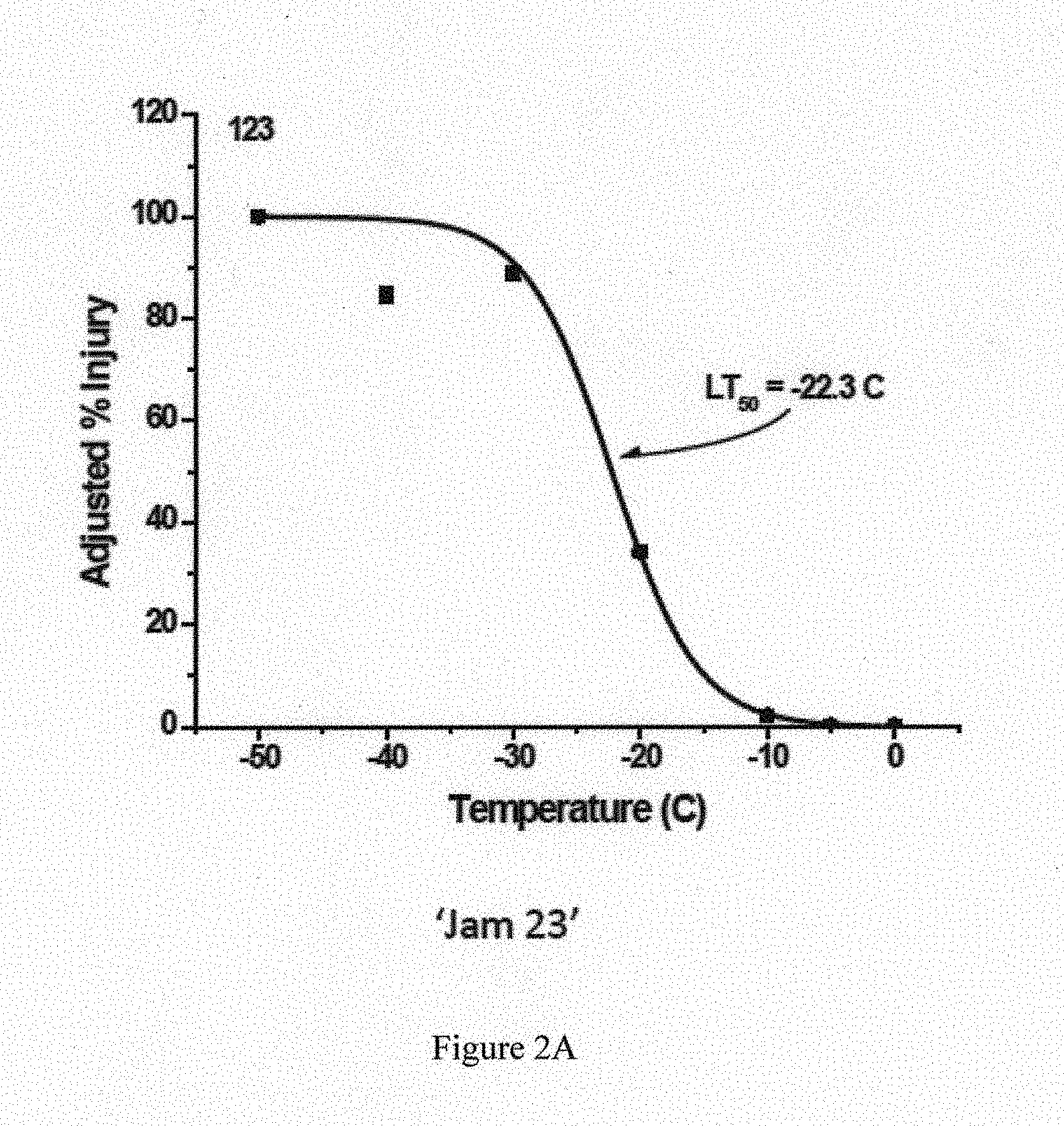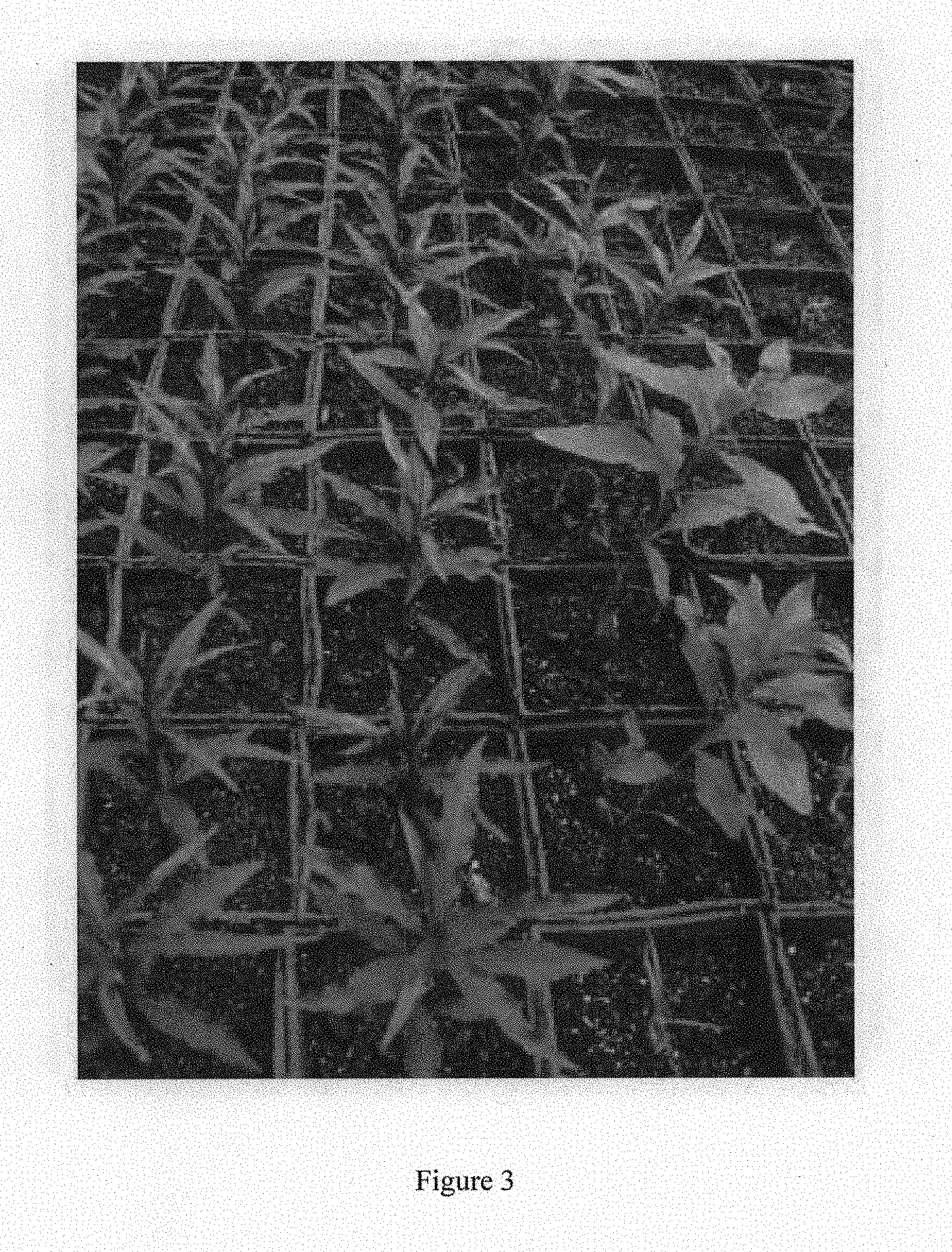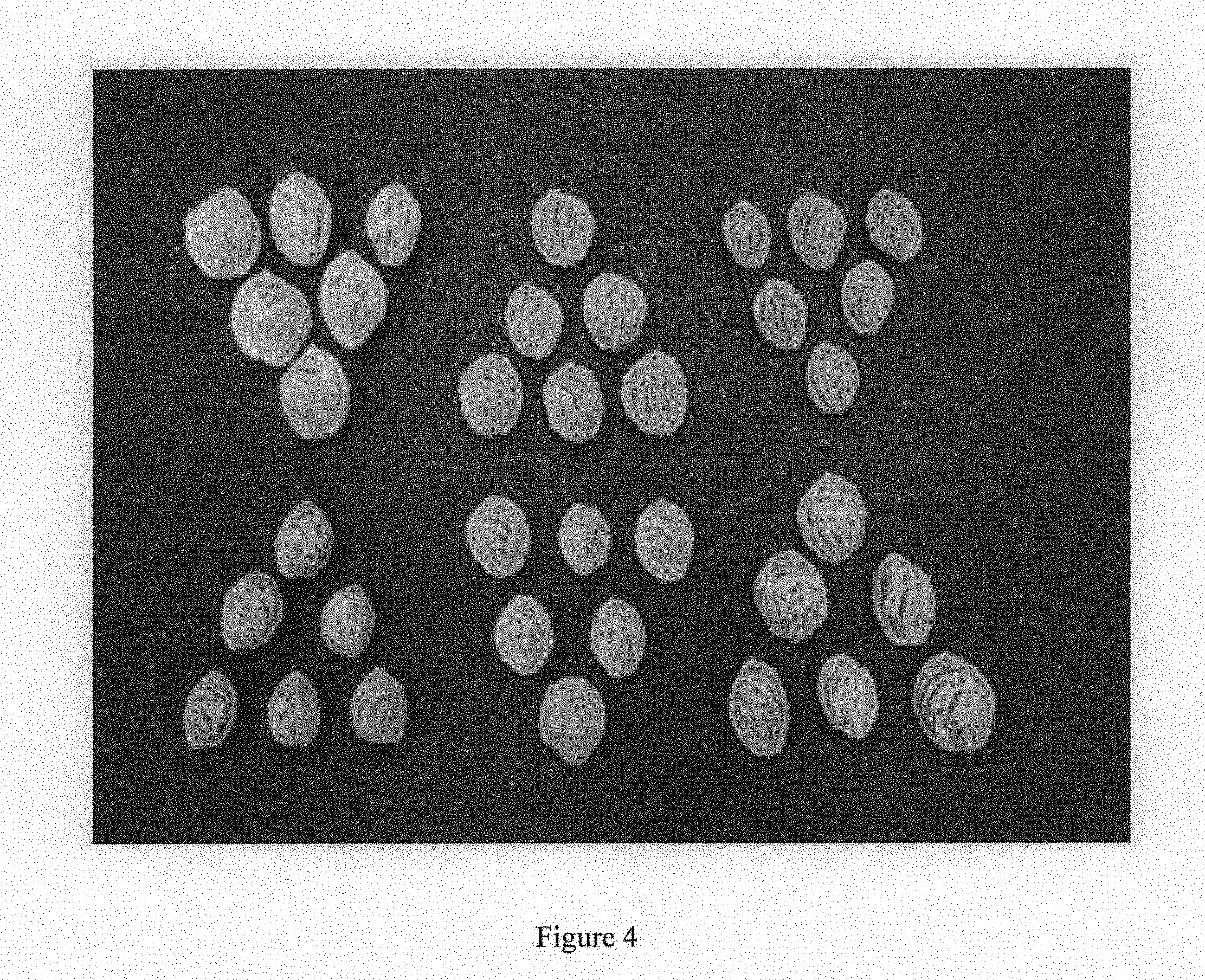'JAM 23' red leaf peach rootstock
Scorza; Ralph
U.S. patent application number 15/732076 was filed with the patent office on 2019-03-14 for 'jam 23' red leaf peach rootstock. The applicant listed for this patent is The United States of America, as represented by the Secretary of Agriculture, The United States of America, as represented by the Secretary of Agriculture. Invention is credited to Ralph Scorza.
| Application Number | 20190082570 15/732076 |
| Document ID | / |
| Family ID | |
| Filed Date | 2019-03-14 |










| United States Patent Application | 20190082570 |
| Kind Code | P1 |
| Scorza; Ralph | March 14, 2019 |
'JAM 23' red leaf peach rootstock
Abstract
This invention relates to new and distinct cultivar of peach rootstock named `Jam 23`. The new cultivar is primarily characterized by its cold hardiness and late blooming making it suitable for the reliable production of rootstock seeds with red leaf color, high levels of germination and cold hardiness.
| Inventors: | Scorza; Ralph; (Sheperdstown, WV) | ||||||||||
| Applicant: |
|
||||||||||
|---|---|---|---|---|---|---|---|---|---|---|---|
| Appl. No.: | 15/732076 | ||||||||||
| Filed: | September 13, 2017 |
| Current U.S. Class: | PLT/194 |
| Class at Publication: | PLT/194 |
| International Class: | A01H 6/74 20180101 A01H006/74 |
Claims
1. We claim a new and distinct variety of red leaf peach tree, `Jam 23`, for the production of cold-hardy red leaf Prunus rootstocks with high levels of germination as illustrated and shown herein.
Description
[0001] Latin name of the genus and species of the plant claimed: `JAM 23` is a new peach rootstock that is a Prunus persica (L.) Batsch.
[0002] Variety denomination: The new peach rootstock claimed is of the variety denominated `JAM 23`, Prunus persica (L.) Batsch.
BACKGROUND OF THE INVENTION
[0003] The present invention relates to the discovery of a new and distinct variety of peach botanically known as Prunus persica (L.) Batsch , and herein referred to as `Jam 23`, as herein described and illustrated. This new and distinct variety of peach tree is cold hardy and late blooming making it suitable for the reliable production of rootstock seeds with red leaf color, high levels of germination and cold hardiness. These seedlings can be used as cold-hardy red-leaf peach rootstocks or rootstocks for any Prunus species compatible with peach (Prunus persica) as a rootstock.
[0004] This new and distinct variety of peach originated at the Appalachian Fruit Research Station at Kearneysville, W. Va. where it was tested. `Jam 23`, is a seedling of KV981549 open pollinated. KV981549 is a hybrid of `Bailey` x KV931777. KV931777 is a seedling of `Bailey` x 14DR60. The parentage of 14DR60, a red leaf peach, is unknown. `Jam 23` was selected in 2001 from a group of 518 seedlings of the before said parents. Testing for 8 years has shown that the variety maintains vigorous growth, red color of leaves, late blooming, and heavy cropping.
[0005] `JAM 23` peach rootstock is distinct from its parents in its combination of late blooming with high yield and flesh that is readily separated from the stone (freestone), with a high germination rate of its seeds (Table 1) and a high level of flower bud and wood cold hardiness, similar to the known cold hardy cultivar `Bailey` (FIG. 1, 2A-2B) favoring consistent production. These traits are combined with the distinct trait of homozygous inheritance of the red leaf trait, so that all progeny exhibit the red leaf trait (FIG. 3) allowing easy selection of rootstock growth in the nursery and in orchards. The cold hardy `Bailey` parentage, the documented flower bud cold hardiness (FIG. 1) and wood cold hardiness of `Jam 23` (FIG. 2A) and replicated tests indicate that seedlings of `Jam 23` are cold hardy rootstock when used as rootstocks.
TABLE-US-00001 TABLE 1 Seed germination following cold chamber (4.degree. C.) stratification from October 21 to March 29 with the stone (endocarp removed) or under natural field conditions with seed stone planted in the field October 18 and evaluated for germination May 15. Cold chamber and field planting were each tests of 3 replications of 15 seeds per replication per cultivar. % Germination Cold Chamber Stratified Seed Removed % Germination Cultivar from Stone Seed in Stone `JAM 23` 98 40 `Bailey` 100 16 `Bounty` 93 7 `Guardian` 87 9 `TruGold` 78 0
[0006] The new variety was propagated using vegetative propagation by bud-grafting on to seedling peach rootstock. Testing for 10 years has shown that said variety maintains late bloom, high fruit and seed productivity, and red leaf-color when bud-grafted onto standard rootstocks. Seedlings of `JAM 23` produced through open-pollination of `Jam 23` trees show a red coloration of leaves and young (non-woody) stems (FIG. 3).
BRIEF DESCRIPTIONS OF THE DRAWINGS
[0007] FIG. 1 is a graph showing Percentage of dead flower buds following exposure of budsticks containing dormant flower buds (Mar. 8, 2011) to controlled low temperatures in a freezing chamber with an average of 5 replications per genotype per temperature and an average of 114 buds sampled per genotype per temperature per replication.
[0008] FIG. 2A is a graph showing lethal low temperature (LT.sub.50) for survival of dormant shoots of `Jam 23` (-22.3.degree. C.), compared with commonly used peach rootstocks shown in FIGS. 2B and 2C, measured by ion leakage. Three replications per genotype per temperature (0, -5, -10, -20, -3-, -50.degree. C.).
[0009] FIG. 2B is a graph showing lethal low temperature (LT.sub.50) for survival of dormant shoots of the cold hardy rootstock `Bailey` (-21.5.degree. C.) measured by ion leakage. Three replications per genotype per temperature (0, -5, -10, -20, -3-, -50.degree. C.).
[0010] FIG. 2C is a graph showing lethal low temperature (LT.sub.50) for survival of dormant shots of the standard rootstock `Lovell` (-20.4.degree. C.), measured by ion leakage. Three replications per genotype per temperature (0, -5, -10, -20, -3-, -50.degree. C.).
[0011] FIG. 3 is a photograph of seedlings of open pollination of `Jam 23` on left side of photograph and green leaf seedlings of `Bailey` on the right side of the photograph.
[0012] FIG. 4 is a photograph showing seeds of `Bounty` (upper left), `Jam 23` (upper middle), `Bailey` (upper right), `Guardian` (lower left), Seedling KV010127 (lower middle), `TruGold` (lower right).
[0013] FIG. 5A is a photograph of emerging leaf color of `Jam 23`.
[0014] FIG. 5B is a photograph showing emerging leaves of `Bailey` rootstock.
[0015] FIG. 5C is a photograph showing Nectaries (glands) of `Jam 23`
[0016] FIG. 5D is a photograph showing leaves from `Bailey` rootstock showing no visible nectaries.
[0017] FIG. 6 is a photograph showing the flower color of `Jam 23`.
DETAILED DESCRIPTION OF THE INVENTION
[0018] `Jam 23` is unique in its combination of red coloration of leaves and young shoots, late bloom, cold hardiness of flower buds and shoots, high germination rate of seeds and the production of seedlings with red leaf and shoot coloration. The red leaf coloration serves to identify the rootstock in grafted trees. In the nursery following propagation by bud-grafting, if the grafted bud does not survive, the growth of the rootstock can be readily observed and these non-grafted trees can be eliminated. In the orchard or home garden, if the grafted scion variety dies at any stage in tree growth and the rootstock takes over the growth of the tree, which is not an uncommon occurrence, `Jam 23` growth can readily be observed by the red leaf and shoot color and the tree can be eliminated or re-grafted to the desired variety. The late bloom and cold hardiness of `Jam 23` as a rootstock seed source assures the production of rootstock seeds in years of extreme cold winters or in the case of late spring season frost events that would kill the flowers of earlier blooming trees and eliminate rootstock seed production. The high germination rate of `Jam 23` seeds assures a good stock of graftable nursery rootstock. `Jam 23` has been tested as selection KV010123 since 2009 as part of the NC-140 Regional Peach Rootstock Trial. Since 2009 these trials have indicated that tree survival, tree growth, fruit yield and fruit size of `Redhaven` peach grafted to seedlings of `Jam 23` is equal to, or in some locations in some years, superior to the experimental trial control rootstock `Lovell`. `Jam 23` rootstock induced a high fruit yield efficiency of the `Redhaven` scion. Over all locations and years of the NC-140 trial to date `Jam 23` has exerted a slight dwarfing effect on the growth of the `Lovell` scion. This effect, which averaged 88% of growth of `Redhaven` on the `Lovell` control rootstock, was noted in many, but not all, test locations. Tree survival of `Jam 23` in all locations was among the highest tested (Reighard et al 2015. Acta Horticulturae 1084: 225-232).
[0019] `Jam 23`, was selected from a group of 518 seedlings of KV981549 that had been open pollinated. `Jam 23` was selected for a high percentage of seed germination, high levels of flower bud and shoot cold hardiness, the homozygous state of the gene for red leaf and shoot coloration, and late bloom, through a series of tests as exemplified in Table 1 above and FIGS. 1, 2A-C, 3, 5A-C, and 6.
DETAILED BOTANICAL DESCRIPTION OF THE PLANT
[0020] The following horticultural description was developed from plant material of the new cultivar growing in Kearneysville, W Va. Trees of `Jam 23` were observed during the growing season 2015. At the time the trees were approximately 15 years old. Color definitions used throughout the following description are from The Royal Horticultural Society Colour Chart. [0021] Tree: [0022] Size.--Canopy 6.3 meters high from the ground at 10 years of age. Canopy 7.1 m in diameter at 10 years of age. [0023] Vigor.--Vigorous -- average seasonal growth of shoots 31.5 cm with a diameter of 3.98 mm. [0024] Growth.--Spreading. [0025] Productivity.--High productivity. [0026] Bearing.--Self-fertile, regular bearing. [0027] Trunk: [0028] Size.--Diameter 15.5 cm (measured at 20 cm above ground level). [0029] Color.--Greyed green N189C. [0030] Branches: [0031] Scaffold branches: [0032] Size.--Average diameter 6.35 cm. [0033] Bark color.--Greyed green 197C to 197B. [0034] Scaffold branch lenticels color.--Greyed green 197C to 197B. length -- 4.9 mm. Width -- 2.4 mm. Density -- 22/cm.sup.2. [0035] Lateral branches: [0036] Bark color.--Greyed brown 199A. [0037] Lenticels.--Color -- greyed orange N167C. Length 1.4 mm. Width 0.7 mm. Density 6.5/cm.sup.2 . Angle from the supporting limb 50.0.degree.. [0038] Leaves: Leaves are lanceolate, apex is acuminate, base is cuneate margin is crenate. [0039] Color.--adaxial -- mature leaves are green group 137B to 137C, older leaves become yellow-green 146A. abaxial -- yellow green 147B. mid-rib -- yellow green 144D with over-color of greyed purple 187C to 185D depending on age and light exposure. [0040] Emerging young leaf color.--Greyed purple 187A-187B. [0041] Petiole: Petiole is longitudinally grooved, color is yellow-green 144C tinged with greyed purple 184A. [0042] Average length.--8.25 mm. [0043] Average width.--1.47 mm. [0044] Average thickness.--1.46 mm. [0045] Blade: [0046] Average length.--14.1 cm. [0047] Average width.--4.0 cm. [0048] Average thickness.--0.13 mm. [0049] Leaf glands: Leaf glands are round, located on petiole and/or base of leaf blade. Color is yellow-green 151B. [0050] Average number.--2. [0051] Average diameter.--0.78 mm. [0052] Flower buds and flowers: [0053] Flower buds: [0054] Color.--Grey 201C over brown N200A. [0055] Average length.--4.2 mm. [0056] Average width.--2.3 mm. [0057] Average # of buds per node.--0.9. [0058] Average # of buds per cm.--0.5. [0059] Bud scale color.--Adaxial greyed-orange 166B streaked with greyed-orange 175B. Abaxial tomentose, brown N200D, over greyed orange 166B. Flower bud cold hardiness similar to that of `Bailey` (see FIG. 3). [0060] Flowers: [0061] Petal color.--Red purple 62C, aging to N66D with stalk and veins red purple 64B. [0062] Average petal length.--18.2 mm. [0063] Average petal width.--14.1 mm. [0064] Average flower diameter.--31.2 mm. [0065] Stamen: [0066] Anther color.--Red 53C. [0067] Average anther length.--0.98 mm. [0068] Average anther width.--0.84 mm. [0069] Average number/flower.--39.6. [0070] Filament: [0071] Average filament length.--11.5 mm. [0072] Filament color.--Red-purple 69B aging to red-purple 64A to 64B. [0073] Pistil: [0074] Overall average length of pistil.--20 mm. [0075] Stigma color.--Yellow-green 154C. [0076] Average diameter.--0.76 mm. [0077] Style color.--Red 53B. [0078] Average diameter.--0.36 mm. [0079] Ovary: [0080] Average height.--3.5 mm. [0081] Average diameter.--2.4 mm. [0082] Color.--Hairs white 155B. Ovary yellow-green 145A. [0083] Hypanthium: [0084] Hypanthium diameter.--6.0 mm. [0085] Hypanthium height.--7.23 mm. [0086] Color.--Abaxial greyed purple 183D. Adaxial yellow-green 151A tinged with greyed oranged 172C. [0087] Calyx (sepals): [0088] Average sepal length.--4.7 mm. [0089] Average sepal width.--4.1 mm. [0090] Color.--Abaxial greyed purple 183D. Adaxial greyed purple 185C. [0091] Fruit: [0092] Average weight.--6.7 g. [0093] Average length.--41.4 mm. [0094] Average width.--40.5 mm. [0095] Average thickness.--39.0 mm. [0096] Flesh thickness.--13.1 mm. [0097] Epidermis ground color.--Green-white 157A to 155B. [0098] Overcolor.--Greyed purple 184C to 184D, some areas of 183B. [0099] Pubescence.--Yellow white 158A. [0100] Flesh color.--White 155C stained with greyed purple 185B to 185A. [0101] Pit cavity color.--White 155C stained with greyed purple 185B to 185A. [0102] Pit cavity depth.--8.1 mm. [0103] Pit cavity width.--10.4.times.13.2 mm. [0104] Penduncle length.--4.3 mm. [0105] Penduncle width.--3.6 mm. Slightly elongated in suture plane. [0106] Average length.--27.7 mm. [0107] Average width.--21.0 mm. [0108] Average diameter.--14.7 mm. [0109] Stone (FIG. 4): [0110] Average weight.--3.2 g. [0111] Average length.--28.7 mm. [0112] Average width.--21.1 mm. [0113] Average thickness.--14.2 mm. Freestone, (stone readily separates from the surrounding flesh) ovoid shape, pointed, pits round to elongated. [0114] Stone color.--Greyed orange 177B to 177A. Stained with greyed purple 185B when wet. [0115] Kernel cavity color.--Greyed orange 165D to 165C. [0116] Kernel: [0117] Average weight.--0.34 g. [0118] Average length.--15.7 mm. [0119] Average width.--9.8 mm. [0120] Average thickness.--4.6 mm. [0121] Average number kernels.--1.04. [0122] Kernel color.--Greyed orange 164B with vein of 164A. Seed germination was high (see Table 1).
* * * * *
D00000

D00001

D00002

D00003

D00004

D00005

D00006

D00007

D00008

D00009

XML
uspto.report is an independent third-party trademark research tool that is not affiliated, endorsed, or sponsored by the United States Patent and Trademark Office (USPTO) or any other governmental organization. The information provided by uspto.report is based on publicly available data at the time of writing and is intended for informational purposes only.
While we strive to provide accurate and up-to-date information, we do not guarantee the accuracy, completeness, reliability, or suitability of the information displayed on this site. The use of this site is at your own risk. Any reliance you place on such information is therefore strictly at your own risk.
All official trademark data, including owner information, should be verified by visiting the official USPTO website at www.uspto.gov. This site is not intended to replace professional legal advice and should not be used as a substitute for consulting with a legal professional who is knowledgeable about trademark law.